what happens to the temperature of the gas during an isobaric expansion?
The Commencement Law of Thermodynamics
xvi Showtime Constabulary of Thermodynamics
Learning Objectives
By the cease of this section, you will be able to:
- State the first law of thermodynamics and explain how it is applied
- Explicate how heat transfer, work done, and internal energy change are related in any thermodynamic process
Now that we take seen how to summate internal energy, heat, and piece of work done for a thermodynamic system undergoing modify during some procedure, we tin see how these quantities interact to touch the amount of modify that tin can occur. This interaction is given past the starting time law of thermodynamics. British scientist and novelist C. P. Snowfall (1905–1980) is credited with a joke about the 4 laws of thermodynamics. His humorous statement of the beginning constabulary of thermodynamics is stated "you can't win," or in other words, you lot cannot get more energy out of a system than you put into it. We will see in this affiliate how internal energy, heat, and piece of work all play a role in the first police force of thermodynamics.
Suppose Q represents the heat exchanged between a system and the surroundings, and Due west is the work done past or on the system. The kickoff law states that the change in internal free energy of that system is given by ![]() . Since added heat increases the internal free energy of a system, Q is positive when it is added to the arrangement and negative when it is removed from the system.
. Since added heat increases the internal free energy of a system, Q is positive when it is added to the arrangement and negative when it is removed from the system.
When a gas expands, it does work and its internal energy decreases. Thus, W is positive when work is washed by the system and negative when work is done on the organisation. This sign convention is summarized in (Effigy). The first constabulary of thermodynamics is stated as follows:
First Law of Thermodynamics
Associated with every equilibrium country of a system is its internal energy ![]() The alter in
The alter in ![]() for any transition between two equilibrium states is
for any transition between two equilibrium states is
![]()
where Q and West represent, respectively, the heat exchanged past the system and the work done by or on the system.
| Thermodynamic Sign Conventions for Rut and Work | |
|---|---|
| Procedure | Convention |
| Heat added to system | |
| Heat removed from arrangement | |
| Work done by system | |
| Piece of work done on system | |
The kickoff law is a statement of energy conservation. Information technology tells united states that a system can exchange free energy with its environment by the transmission of heat and by the operation of work. The net energy exchanged is and then equal to the alter in the total mechanical energy of the molecules of the system (i.e., the organisation'southward internal energy). Thus, if a arrangement is isolated, its internal energy must remain constant.
Although Q and W both depend on the thermodynamic path taken between 2 equilibrium states, their difference ![]() does non. (Figure) shows the pV diagram of a organization that is making the transition from A to B repeatedly along dissimilar thermodynamic paths. Forth path 1, the organisation absorbs oestrus
does non. (Figure) shows the pV diagram of a organization that is making the transition from A to B repeatedly along dissimilar thermodynamic paths. Forth path 1, the organisation absorbs oestrus ![]() and does work
and does work ![]() forth path two, it absorbs heat
forth path two, it absorbs heat ![]() and does work
and does work ![]() and so on. The values of
and so on. The values of ![]() and
and ![]() may vary from path to path, only we have
may vary from path to path, only we have
![]()
or
![]()
That is, the change in the internal energy of the arrangement between A and B is path independent. In the affiliate on potential energy and the conservation of free energy, nosotros encountered another path-contained quantity: the change in potential energy between two arbitrary points in infinite. This change represents the negative of the work done by a conservative forcefulness between the 2 points. The potential free energy is a office of spatial coordinates, whereas the internal free energy is a role of thermodynamic variables. For example, we might write ![]() for the internal energy. Functions such as internal free energy and potential energy are known as land functions because their values depend solely on the state of the arrangement.
for the internal energy. Functions such as internal free energy and potential energy are known as land functions because their values depend solely on the state of the arrangement.
Different thermodynamic paths taken past a system in going from land A to land B. For all transitions, the modify in the internal energy of the system ![]() is the same.
is the same.
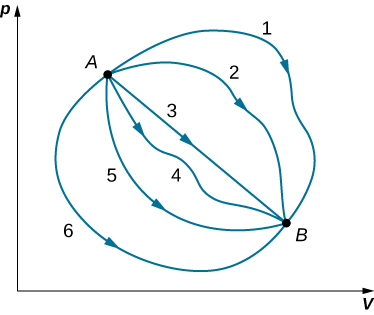
Often the commencement law is used in its differential form, which is
![]()
Here ![]() is an minute modify in internal free energy when an minute amount of rut dQ is exchanged with the system and an infinitesimal amount of work dW is done by (positive in sign) or on (negative in sign) the system.
is an minute modify in internal free energy when an minute amount of rut dQ is exchanged with the system and an infinitesimal amount of work dW is done by (positive in sign) or on (negative in sign) the system.
Changes of Land and the First Law During a thermodynamic procedure, a organisation moves from state A to state B, information technology is supplied with 400 J of heat and does 100 J of work. (a) For this transition, what is the organization'south change in internal energy? (b) If the system and so moves from country B dorsum to state A, what is its change in internal energy? (c) If in moving from A to B along a different path, ![]() of work is washed on the system, how much heat does it absorb?
of work is washed on the system, how much heat does it absorb?
Strategy The first police force of thermodynamics relates the internal energy change, piece of work done past the system, and the estrus transferred to the organization in a simple equation. The internal energy is a function of land and is therefore stock-still at whatever given point regardless of how the system reaches the land.
Solution
- From the first police force, the alter in the system'south internal energy is

- Consider a closed path that passes through the states A and B. Internal energy is a state part, and then
 is zero for a airtight path. Thus
is zero for a airtight path. Thus

and

This yields

- The change in internal free energy is the aforementioned for any path, so

and the estrus exchanged is

The negative sign indicates that the system loses oestrus in this transition.
Significance When a airtight cycle is considered for the first law of thermodynamics, the change in internal energy around the whole path is equal to null. If friction were to play a role in this instance, less work would event from this oestrus added. (Figure) takes into consideration what happens if friction plays a role.
Notice that in (Figure), nosotros did non assume that the transitions were quasi-static. This is because the beginning law is non subject to such a restriction. Information technology describes transitions betwixt equilibrium states but is not concerned with the intermediate states. The system does not have to pass through merely equilibrium states. For example, if a gas in a steel container at a well-defined temperature and pressure is made to explode by means of a spark, some of the gas may condense, different gas molecules may combine to form new compounds, and in that location may be all sorts of turbulence in the container—only eventually, the arrangement will settle down to a new equilibrium state. This system is clearly not in equilibrium during its transition; however, its behavior is yet governed by the first law because the process starts and ends with the system in equilibrium states.
Polishing a Fitting A machinist polishes a 0.50-kg copper plumbing fixtures with a piece of emery fabric for 2.0 min. He moves the cloth across the fitting at a constant speed of 1.0 g/s by applying a forcefulness of twenty N, tangent to the surface of the fitting. (a) What is the total work done on the plumbing equipment by the machinist? (b) What is the increment in the internal energy of the fitting? Presume that the change in the internal energy of the cloth is negligible and that no heat is exchanged between the fitting and its surroundings. (c) What is the increment in the temperature of the fitting?
Strategy The machinist's force over a altitude that can be calculated from the speed and time given is the piece of work washed on the organisation. The work, in turn, increases the internal free energy of the system. This free energy tin can be interpreted as the heat that raises the temperature of the arrangement via its heat capacity. Exist careful with the sign of each quantity.
Solution
- The power created by a force on an object or the charge per unit at which the machinist does frictional work on the fitting is
 . Thus, in an elapsed time
. Thus, in an elapsed time  (two.0 min), the work done on the plumbing fixtures is
(two.0 min), the work done on the plumbing fixtures is

- By assumption, no heat is exchanged between the fitting and its environment, so the first law gives for the change in the internal energy of the plumbing fixtures:

- Since
 is path independent, the effect of the
is path independent, the effect of the  of piece of work is the same every bit if it were supplied at atmospheric pressure by a transfer of heat. Thus,
of piece of work is the same every bit if it were supplied at atmospheric pressure by a transfer of heat. Thus,

and the increment in the temperature of the fitting is

where we have used the value for the specific heat of copper, .
.
Significance If heat were released, the change in internal energy would exist less and crusade less of a temperature change than what was calculated in the trouble.
An Ideal Gas Making Transitions between Ii States Consider the quasi-static expansions of an ideal gas between the equilibrium states A and C of (Effigy). If 515 J of estrus are added to the gas as it traverses the path ABC, how much heat is required for the transition forth ADC? Assume that ![]() and
and ![]()
Strategy The departure in work washed between process ABC and process ADC is the area enclosed by ABCD. Because the modify of the internal free energy (a function of state) is the aforementioned for both processes, the deviation in work is thus the same as the difference in rut transferred to the system.
Solution For path ABC, the rut added is ![]() and the work done by the gas is the expanse under the path on the pV diagram, which is
and the work done by the gas is the expanse under the path on the pV diagram, which is
![]()
Along ADC, the piece of work done past the gas is once more the area under the path:
![]()
And then using the strategy nosotros but described, we have
![]()
which leads to
![]()
Significance The work calculations in this problem are made simple since no piece of work is washed along AD and BC and forth AB and DC; the pressure is abiding over the volume change, and so the work washed is simply ![]() . An isothermal line could also have been used, as we have derived the work for an isothermal process equally
. An isothermal line could also have been used, as we have derived the work for an isothermal process equally ![]() .
.
Isothermal Expansion of an Ideal Gas Oestrus is added to i mol of an platonic monatomic gas bars to a cylinder with a movable piston at one finish. The gas expands quasi-statically at a abiding temperature of 300 Thousand until its volume increases from V to 3V. (a) What is the modify in internal free energy of the gas? (b) How much piece of work does the gas do? (c) How much heat is added to the gas?
Strategy (a) Because the system is an ideal gas, the internal energy only changes when the temperature changes. (b) The heat added to the arrangement is therefore purely used to practise work that has been calculated in Work, Heat, and Internal Energy. (c) Lastly, the first law of thermodynamics can be used to calculate the rut added to the gas.
Solution
- Nosotros saw in the preceding section that the internal energy of an ideal monatomic gas is a function only of temperature. Since
 , for this process,
, for this process, 
- The quasi-static isothermal expansion of an ideal gas was considered in the preceding section and was found to be

- With the results of parts (a) and (b), nosotros can use the start police force to make up one's mind the rut added:

which leads to

Significance An isothermal process has no change in the internal free energy. Based on that, the kickoff law of thermodynamics reduces to ![]() .
.
Bank check Your Understanding Why was it necessary to country that the process of (Effigy) is quasi-static?
And so that the process is represented past the curve ![]() on the pV plot for the evaluation of work.
on the pV plot for the evaluation of work.
Vaporizing Water When 1.00 yard of h2o at ![]() changes from the liquid to the gas stage at atmospheric pressure, its change in book is
changes from the liquid to the gas stage at atmospheric pressure, its change in book is ![]() (a) How much heat must be added to vaporize the water? (b) How much piece of work is done by the water against the atmosphere in its expansion? (c) What is the alter in the internal energy of the water?
(a) How much heat must be added to vaporize the water? (b) How much piece of work is done by the water against the atmosphere in its expansion? (c) What is the alter in the internal energy of the water?
Strategy We tin starting time figure out how much heat is needed from the latent heat of vaporization of the water. From the volume change, we tin calculate the work washed from ![]() because the pressure is constant. And so, the first police force of thermodynamics provides the states with the change in the internal energy.
because the pressure is constant. And so, the first police force of thermodynamics provides the states with the change in the internal energy.
Solution
- With
 representing the latent heat of vaporization, the heat required to vaporize the h2o is
representing the latent heat of vaporization, the heat required to vaporize the h2o is

- Since the pressure level on the arrangement is abiding at
 , the work done by the water as information technology is vaporized is
, the work done by the water as information technology is vaporized is

- From the first police, the thermal energy of the water during its vaporization changes past

Significance Nosotros annotation that in part (c), we run across a change in internal energy, even so there is no modify in temperature. Platonic gases that are not undergoing phase changes take the internal free energy proportional to temperature. Internal energy in full general is the sum of all energy in the system.
Check Your Understanding When ane.00 chiliad of ammonia boils at atmospheric pressure and ![]() its volume changes from 1.47 to
its volume changes from 1.47 to ![]() . Its heat of vaporization at this pressure is
. Its heat of vaporization at this pressure is ![]() What is the change in the internal free energy of the ammonia when information technology vaporizes?
What is the change in the internal free energy of the ammonia when information technology vaporizes?
![]()
View this site to larn nigh how the showtime law of thermodynamics. First, pump some heavy species molecules into the chamber. So, play effectually by doing piece of work (pushing the wall to the right where the person is located) to see how the internal free energy changes (as seen past temperature). And then, expect at how heat added changes the internal energy. Finally, you can set a parameter constant such as temperature and see what happens when you do work to keep the temperature constant (Annotation: You might see a change in these variables initially if you are moving effectually quickly in the simulation, but ultimately, this value will return to its equilibrium value).
Summary
- The internal free energy of a thermodynamic system is a office of country and thus is unique for every equilibrium state of the arrangement.
- The increase in the internal energy of the thermodynamic system is given past the heat added to the arrangement less the work done past the system in whatever thermodynamics process.
Conceptual Questions
What does the outset law of thermodynamics tell usa about the energy of the universe?
Does adding heat to a system ever increase its internal energy?
If more piece of work is done on the arrangement than oestrus added, the internal energy of the system will really decrease.
A groovy bargain of effort, time, and money has been spent in the quest for a so-chosen perpetual-motion machine, which is divers every bit a hypothetical motorcar that operates or produces useful work indefinitely and/or a hypothetical automobile that produces more work or energy than it consumes. Explain, in terms of the get-go law of thermodynamics, why or why not such a machine is likely to be constructed.
Problems
When a dilute gas expands quasi-statically from 0.l to 4.0 L, information technology does 250 J of work. Assuming that the gas temperature remains constant at 300 Thousand, (a) what is the change in the internal free energy of the gas? (b) How much heat is absorbed by the gas in this process?
In a quasi-static isobaric expansion, 500 J of work are washed past the gas. The gas pressure is 0.fourscore atm and information technology was originally at xx.0 Fifty. If the internal energy of the gas increased by 80 J in the expansion, how much heat does the gas absorb?
580 J
An ideal gas expands quasi-statically and isothermally from a land with force per unit area p and book Five to a state with volume 4V. How much heat is added to the expanding gas?
As shown below, if the heat captivated past the gas forth AB is 400 J, determine the quantities of heat absorbed along (a) ADB; (b) ACB; and (c) ADCB.
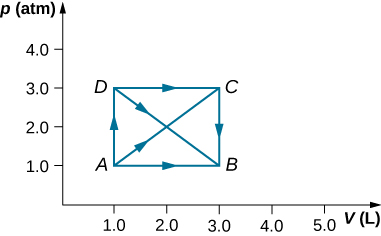
a. 600 J; b. 600 J; c. 800 J
During the isobaric expansion from A to B represented beneath, 130 J of heat are removed from the gas. What is the change in its internal free energy?
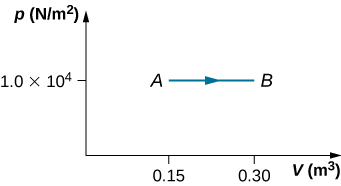
(a) What is the modify in internal energy for the procedure represented by the closed path shown below? (b) How much oestrus is exchanged? (c) If the path is traversed in the opposite direction, how much heat is exchanged?
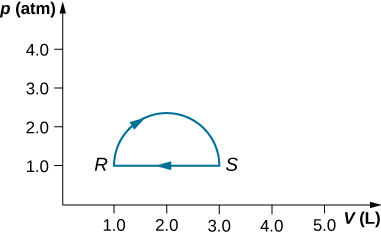
a. 0; b. 160 J; c. –160 J
When a gas expands forth path AC shown below, it does 400 J of piece of work and absorbs either 200 or 400 J of estrus. (a) Suppose yous are told that forth path ABC, the gas absorbs either 200 or 400 J of heat. Which of these values is correct? (b) Give the correct answer from function (a), how much work is done past the gas along ABC? (c) Along CD, the internal free energy of the gas decreases by 50 J. How much heat is exchanged by the gas forth this path?
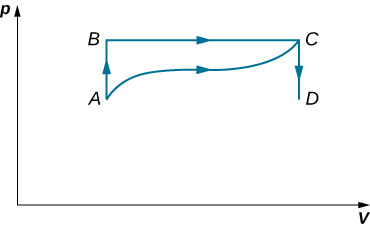
When a gas expands forth AB (see below), it does 500 J of work and absorbs 250 J of heat. When the gas expands along Air conditioning, it does 700 J of work and absorbs 300 J of rut. (a) How much heat does the gas exchange along BC? (b) When the gas makes the transmission from C to A forth CDA, 800 J of work are washed on it from C to D. How much heat does it exchange along CDA?
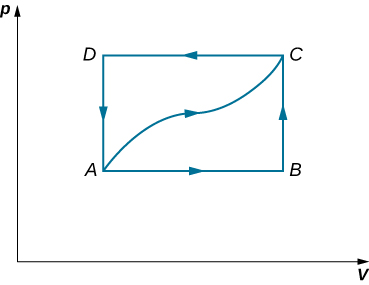
a. –150 J; b. –400 J
A dilute gas is stored in the left chamber of a container whose walls are perfectly insulating (run into beneath), and the right chamber is evacuated. When the partition is removed, the gas expands and fills the entire container. Calculate the work done past the gas. Does the internal free energy of the gas change in this procedure?
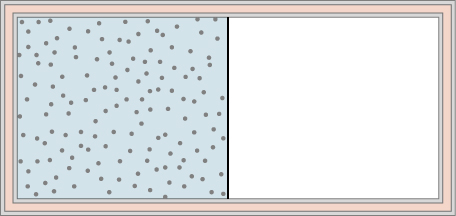
Ideal gases A and B are stored in the left and right chambers of an insulated container, every bit shown below. The sectionalisation is removed and the gases mix. Is any piece of work done in this procedure? If the temperatures of A and B are initially equal, what happens to their mutual temperature after they are mixed?
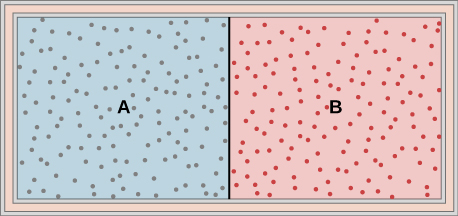
No piece of work is done and they reach the same mutual temperature.
An ideal monatomic gas at a pressure of ![]() and a temperature of 300 K undergoes a quasi-static isobaric expansion from
and a temperature of 300 K undergoes a quasi-static isobaric expansion from ![]() (a) What is the work washed by the gas? (b) What is the temperature of the gas after the expansion? (c) How many moles of gas are there? (d) What is the change in internal energy of the gas? (eastward) How much heat is added to the gas?
(a) What is the work washed by the gas? (b) What is the temperature of the gas after the expansion? (c) How many moles of gas are there? (d) What is the change in internal energy of the gas? (eastward) How much heat is added to the gas?
Consider the process for steam in a cylinder shown beneath. Suppose the modify in the internal energy in this process is 30 kJ. Observe the heat entering the arrangement.
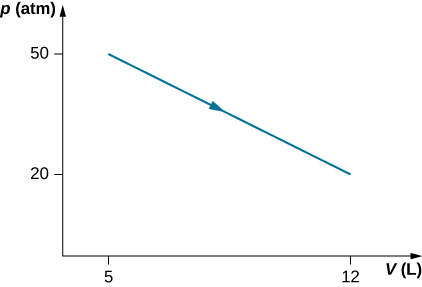
54,500 J
The state of thirty moles of steam in a cylinder is changed in a cyclic manner from a-b-c-a, where the force per unit area and volume of the states are: a (xxx atm, 20 50), b (l atm, 20 L), and c (50 atm, 45 Fifty). Assume each change takes place along the line connecting the initial and final states in the pV plane. (a) Display the cycle in the pV aeroplane. (b) Find the net work done by the steam in one cycle. (c) Find the internet amount of estrus flow in the steam over the course of one cycle.
A metallic container of stock-still volume of ![]() immersed in a large tank of temperature
immersed in a large tank of temperature ![]() contains 2 compartments separated past a freely movable wall. Initially, the wall is kept in identify by a stopper so that in that location are 0.02 mol of the nitrogen gas on one side and 0.03 mol of the oxygen gas on the other side, each occupying half the volume. When the stopper is removed, the wall moves and comes to a final position. The move of the wall is controlled and then that the wall moves in infinitesimal quasi-static steps. (a) Find the final volumes of the two sides assuming the ideal gas behavior for the 2 gases. (b) How much piece of work does each gas do on the other? (c) What is the change in the internal energy of each gas? (d) Discover the amount of rut that enters or leaves each gas.
contains 2 compartments separated past a freely movable wall. Initially, the wall is kept in identify by a stopper so that in that location are 0.02 mol of the nitrogen gas on one side and 0.03 mol of the oxygen gas on the other side, each occupying half the volume. When the stopper is removed, the wall moves and comes to a final position. The move of the wall is controlled and then that the wall moves in infinitesimal quasi-static steps. (a) Find the final volumes of the two sides assuming the ideal gas behavior for the 2 gases. (b) How much piece of work does each gas do on the other? (c) What is the change in the internal energy of each gas? (d) Discover the amount of rut that enters or leaves each gas.
A gas in a cylindrical airtight container is adiabatically and quasi-statically expanded from a land A (three MPa, two Fifty) to a state B with book of 6 50 forth the path ![]() (a) Plot the path in the pV plane. (b) Observe the amount of work done past the gas and the modify in the internal energy of the gas during the process.
(a) Plot the path in the pV plane. (b) Observe the amount of work done past the gas and the modify in the internal energy of the gas during the process.
a.
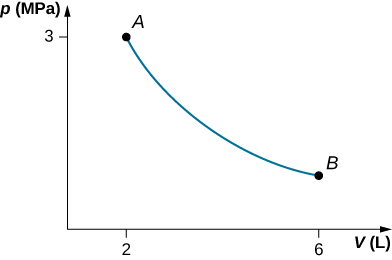
;
b. ![]()
Glossary
- first police of thermodynamics
- the change in internal free energy for whatever transition between 2 equilibrium states is

Source: https://opentextbc.ca/universityphysicsv2openstax/chapter/first-law-of-thermodynamics/
Enregistrer un commentaire for "what happens to the temperature of the gas during an isobaric expansion?"